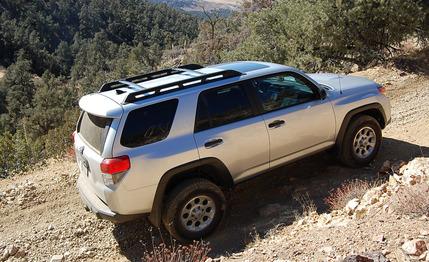
 Short Take Road Test
Short Take Road Test
Remember the previous Toyota 4Runner? Yeah, neither do we. Toyota’s compact, pickup-based, do-it-all four-by-four helped ignite the SUV craze when it launched in 1984. But in the years that followed, the 4Runner became increasingly marginalized as Toyota flooded its dealers with trucks and crossovers intended to plug every conceivable niche. The 2003–09 fourth generation bore little resemblance to the cheap, scrappy 4Runner we fondly remember, having retreated upmarket as a dedicated mall cruiser offering an optional V-8 and leather-laminated cabin. Annual sales dwindled to fewer than 50,000 units.


For 2010, Toyota is trying a retro reboot of sorts, returning to a simpler time with a truck aimed at outdoorsy buyers who like the FJ Cruiser, with which the 4Runner shares its frame and major components, but want proper rear doors. Even so, volume is expected to remain small at perhaps 35,000 units, says Toyota.
FJ Underneath, More Conventional Up Top
Basics: Like the Tacoma pickup and FJ Cruiser, the Japanese-built 4Runner shares the tough, fully boxed frame of the Land Cruiser Prado, a sort of Land Cruiser “Lite” sold in overseas markets (and in the U.S. as the Lexus GX460). The wheelbase remains unchanged from the old 4Runner, but the truck is slightly longer, slightly wider, and at 4780 pounds for our test vehicle, about 130 pounds heavier than our last 4Runner tester.
The V-8 is gone; the engine choices are now a 2.7-liter four-cylinder with 157 hp and a 4.0-liter V-6 making 270 hp, 10 more than the outgoing 4.7-liter V-8. The four-cylinder gets a four-speed automatic, the V-6 a five-speed auto.
The venerable SR5 remains as the entry point and the trim level most buyers will go for. The posh Limited returns to answer the needs of those few who wish to spend $40,000 on an old-fashioned body-on-frame SUV. In between, Toyota introduces the Trail, an off-road-oriented 4Runner and the model tested here. With its sparse exterior decoration and blacked-out fender flares, the Trail reminds us most of the original, Reagan-era 4Runner except that it comes only as a four-by-four with a V-6, a lockable rear differential, electronic off-roading aids such as "Multi-terrain Select” and "Crawl Control,” 17-inch wheels with 32-inch off-road tires, and a longish roster of amenities lifted from various SR5 option packs. The Trail’s subsequent lofty price—it starts at $36,500—might put it out of reach for buyers who pine for the more serious dirt lovers such as the Jeep Wrangler and Nissan Xterra.
The oddly sporty on-the-floor seating of previous 4Runners is largely gone. As in the FJ, the new 4Runner’s seats are higher, the head and knee clearances are generous, and the sightlines and controls more like those of other traditional SUVs such as the Kia Borrego. Ingress and egress are easy, and cargo loading and weekend tailgating are aided by a slide-out tray that holds 440 pounds, standard on the Trail.
Some Agility and Good Ride On-Road, Awesome Off-Road
Despite its weight, the 4Runner is a spry errand runner in the city with a surprisingly compliant ride and a well-hushed cabin. The frame reinforcing that added weight (along with beefier axles) pays its dividends here with a shiver-free ride over pavement blight. The 4.0-liter V-6 with its five-speed automatic (as before, no manual is offered) keeps pace with traffic easily enough, although at 7.8 seconds to 60 mph, it proved slower by 0.6 second than the last 4Runner we tested in April 2005. A green “eco” light in the dash comes on when you’re being thrifty on the throttle, and we averaged 18 mpg over a mix of highway cruising and off-road slogging (Toyota claims 17 city/22 highway for the 4WD V-6 and 18/23 for the four-cylinder).
Off-road, the Trail really proves its worth. Up a steep climb to an 8000-foot peak in the California highlands, the 4Runner was unstoppable, scrambling confidently over loose gravel and large roots and even pausing to tow a pinned Toyota pickup out of a tight spot. The four-wheel-drive system is off-road only and old-fashioned. A manual console shifter selects among “two high,” “four high,” and “four low” in a no-differential transfer case with a 2.6:1 low-gear reduction (Limited models have a more sophisticated electronic all-wheel drive), and a button engages the rear locker.
With Crawl Control, selectable after you put it in four low, the truck will self-regulate its speed up to 3 mph, automatically activating individual wheel brakes to shift torque side to side for best traction. It rolls the truck confidently—although leisurely—over trail obstacles. For experienced off-roaders, it’s a bit of a gimmick, although the Multi-terrain Select, which has five settings for various surfaces from sand to hard slickrock, tunes the throttle response and transmission shift points to the surfaces—all of which indeed make it easier to ease the 4Runner up a challenging trail, dashboard ablaze with lights indicating the various electronic helpers at work.
More sophisticated and everyday usable than a Jeep Wrangler, the 2010 4Runner is also more opulent-feeling than a Nissan Xterra or Kia Borrego (which, with its optional V-8, has a higher tow capacity than the V-6 4Runner’s only so-so 5000 pounds). The 4Runner remains what it has been: a somewhat old-fashioned body-on-frame adventurer for buyers not afraid of its substantial price premium. That niche, as we’ve noted, isn’t nearly as big as the all outdoors.
(Another version of this story can be found in the March 2010 issue of Car and Driver magazine.)